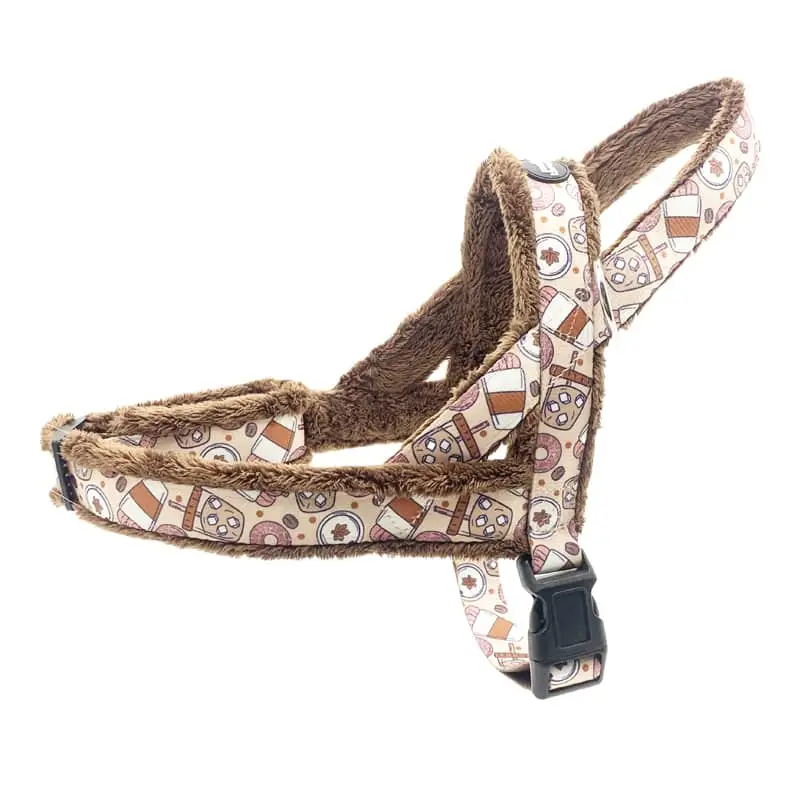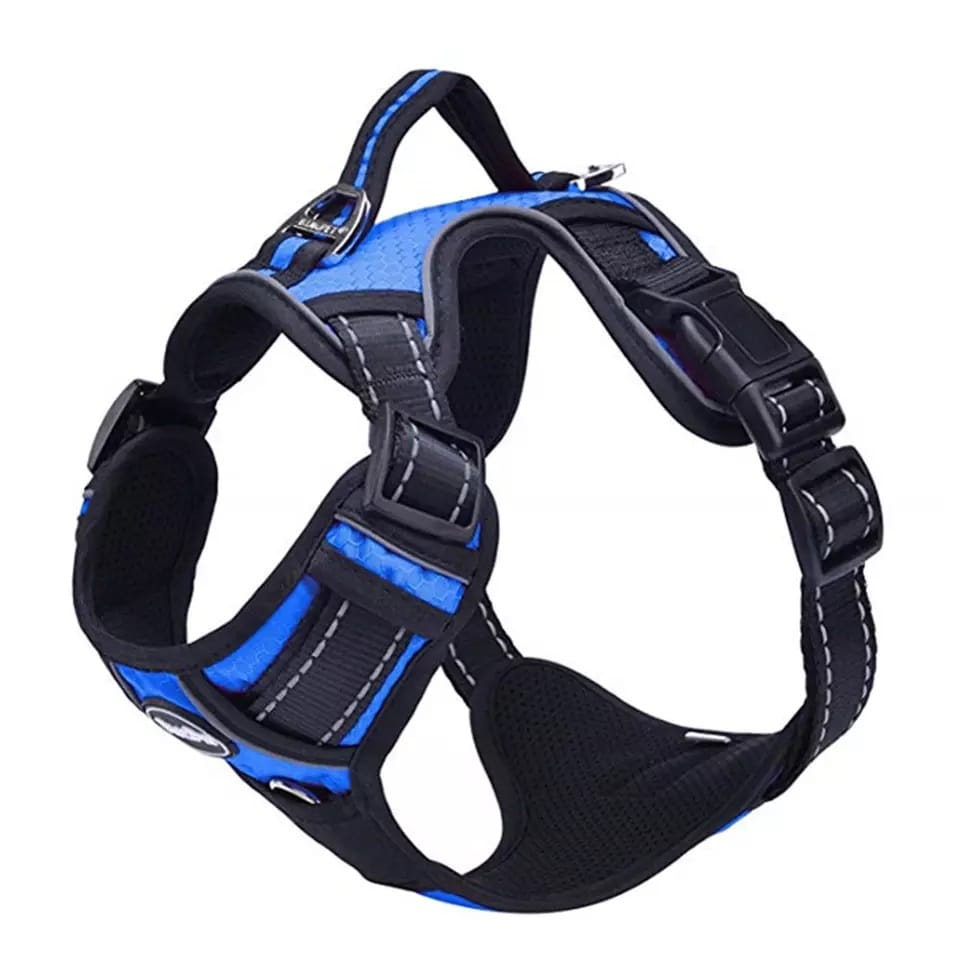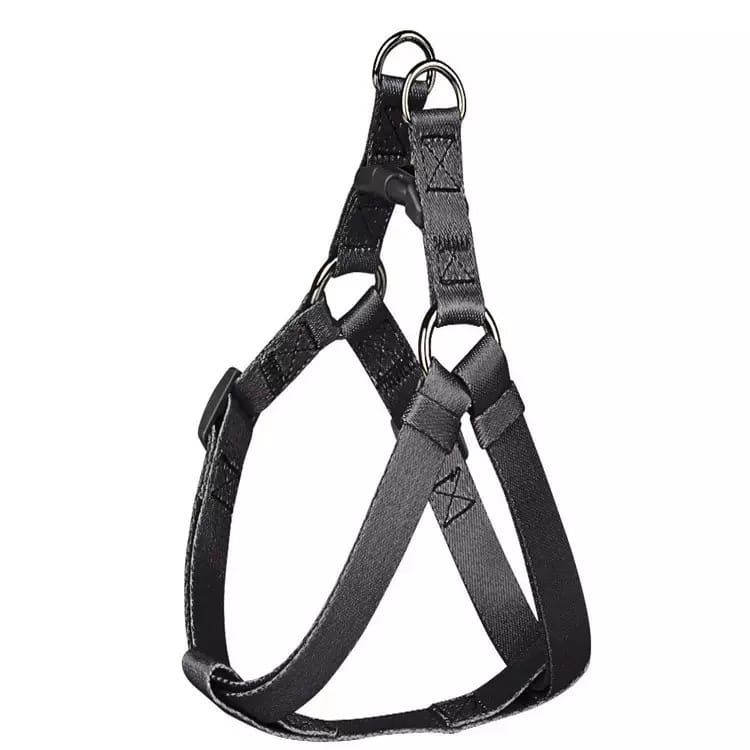
1. Introduction: Understanding Dog Harnesses
When it comes to walking your dog, choosing the right gear is a big decision. Dog harnesses have surged in popularity as an alternative to traditional collars, but not everyone agrees they’re the best choice. So, are harnesses bad for dogs, or are they a safer, more comfortable option? Let’s break it down.
What Is a Dog Harness?
A dog harness is a piece of equipment that wraps around your dog’s torso, securing over the chest and back rather than the neck. Unlike collars, which can put strain on a dog’s throat, harnesses distribute pressure more evenly across the body. This design aims to improve safety and give you better control—especially for dogs that pull or have health issues like breathing difficulties.
Types of Harnesses
Harnesses come in various styles to suit different needs:
- Back-clip harnesses: Leash attaches at the back—perfect for calm, well-behaved dogs.
- Front-clip harnesses: Leash attaches at the chest—great for training dogs that pull.
- Dual-clip harnesses: Offer both front and back clips for flexibility.
You can explore more about these options in our guide to 8 types of dog harnesses.
Why the Debate?
While many pet owners swear by harnesses, others worry they might encourage pulling or cause discomfort if not used correctly. The truth lies in understanding both the benefits and potential downsides. In this article, we’ll dive deep into the pros and cons, expert opinions, and practical tips to help you decide if a harness is right for your furry friend. Whether you’re a new dog owner or looking to switch from a collar, this guide has you covered.
2. Key Takeaways: Harnesses at a Glance
Before we get into the details, here’s a quick snapshot of how harnesses stack up against collars. This comparison highlights safety, control, comfort, and training—key factors every dog owner should consider.
Harnesses vs. Collars: A Quick Comparison
| Feature | Harnesses | Collars |
|---|---|---|
| Safety | Prevents neck injuries, ideal for dogs with respiratory issues | Can cause neck strain or injury if the dog pulls |
| Control | Better for large or strong dogs, front-clip reduces pulling | Simple to use, suits well-mannered dogs |
| Comfort | Even pressure distribution across the body | May dig into the neck during pulling |
| Training | Front-clip aids in teaching leash manners | Martingale collars help prevent escapes |
Pro Tip for Fit
Quick Tip: Measure your dog’s chest girth (behind the front legs) for a perfect fit. A good harness lets you slip two fingers under the straps—snug but not tight.
Why This Matters
This table gives you a starting point to weigh your options. Harnesses shine in safety and control, while collars are simpler for dogs that don’t pull. The right choice depends on your dog’s size, behavior, and health needs—details we’ll explore next.
3. Benefits of Using a Harness for Your Dog
Harnesses have earned their popularity for a reason. They offer several advantages that can make walks safer and more enjoyable for both you and your dog. Here’s why so many pet owners choose them.
Safer for the Neck
One of the biggest perks is how harnesses protect your dog’s neck. Collars can press on the throat when a dog pulls, risking injuries like tracheal collapse—especially in small breeds like Yorkies or Chihuahuas. Harnesses spread the force across the chest and shoulders, keeping the neck free from strain.
Improved Control
For owners of large or energetic dogs, harnesses are a game-changer. They give you more leverage to manage your dog’s movements, reducing the chance of them breaking free. Front-clip harnesses, in particular, help redirect pulling dogs back toward you, making walks less of a tug-of-war. Learn more in our tactical dog harness guide.
Great for Breathing Issues
Dogs with flat faces—like pugs, bulldogs, or Frenchies—often struggle with breathing. Collars can worsen this by squeezing the windpipe, but harnesses keep the pressure off the neck. This makes them a top pick for brachycephalic breeds, ensuring safer and happier walks.
Training Made Easier
Harnesses can double as training tools. Front-clip designs gently guide your dog back when they pull, encouraging better leash habits. They’re especially useful for puppies or dogs still learning to walk politely. Pair this with consistent training, and you’ve got a recipe for success.
4. Potential Drawbacks of Dog Harnesses
While harnesses have plenty of upsides, they’re not flawless. There are some potential downsides to consider to ensure you’re using them wisely.
Can Encourage Pulling
Here’s a twist: some harnesses might make pulling worse. A 2021 study found that dogs pull harder in harnesses because the pressure on their body mimics what sled dogs feel—urging them forward. Front-clip harnesses can counter this, but it’s something to watch.
Injury Risks
A poorly fitted harness can cause trouble. Too tight, and it might chafe or irritate the skin. Too loose, and your dog could slip out—or worse, hurt their chest from pulling. Always check the fit and inspect for rubbing after use to keep your pup safe.
Comfort Concerns
Not every dog loves a harness. Some find them restrictive, especially if they’re new to wearing one. Signs of discomfort—like freezing or refusing to walk—mean it’s time to adjust the fit or try a different style. Padded harnesses might help.
Making It Work
These drawbacks don’t mean harnesses are bad—they just need the right approach. Proper fitting and gradual introduction can turn these cons into non-issues, ensuring your dog stays happy and healthy.
5. How to Choose and Properly Fit a Harness
Selecting the right harness and ensuring a proper fit are critical for your dog’s comfort and safety. A poorly chosen or ill-fitting harness can cause discomfort or even injury, so follow these steps to get it right.
Measure Your Dog
First, measure your dog’s chest girth, which is the widest part just behind the front legs. Use a flexible tape measure for precision. Some harnesses also require a neck measurement, so consult the sizing chart provided by the manufacturer. Sizes differ across brands, so don’t assume a “medium” from one company matches another.
Pick the Right Type
Harnesses come in various styles, each suited to different needs:
- Back-clip harnesses: Perfect for calm dogs that don’t pull excessively.
- Front-clip harnesses: Great for training dogs that tend to pull on the leash.
- Dual-clip harnesses: Provide flexibility with both front and back attachment points.
For breeds with breathing difficulties, like bulldogs or pugs, choose a padded, vest-style harness to evenly distribute pressure. Need help deciding? Check out our guide to dog harness types.
Adjust the Straps
After selecting a harness, adjust the straps to fit snugly. You should be able to slide two fingers under each strap—secure enough to prevent slipping, but loose enough to avoid pinching. Pay special attention to the armpit area to avoid chafing.
Check for Movement
Observe your dog walking in the harness. It shouldn’t restrict shoulder movement or cause skin to bunch up, which indicates it’s too tight. A properly fitted harness stays in place without shifting.
6. Harnesses vs. Collars: Which Is Better?
The choice between a harness and a collar hinges on your dog’s specific needs—behavior, size, and health all play a role. Here’s a breakdown to guide your decision.
Collars: Pros and Cons
- Pros: Simple to use, ideal for attaching ID tags, and sufficient for dogs that walk calmly without pulling. Specialty collars like martingales can prevent escape for breeds with slender heads.
- Cons: Risky for pullers, as they can strain the neck, potentially causing tracheal damage. Small breeds and dogs with respiratory issues are especially vulnerable.
Explore more in our guide to dog collars.
Harnesses: Pros and Cons
- Pros: Safer for the neck, offering better control for strong or large dogs. Front-clip harnesses excel in training, and they’re recommended for breeds with breathing challenges.
- Cons: Typically more expensive than collars, and improper fit can lead to discomfort. Some designs may inadvertently encourage pulling without proper training.
Dive deeper with our harness vs. collar comparison.
When to Choose Each
Opt for a harness if your dog pulls, has health issues, or requires training. Collars work well for relaxed dogs with good leash manners—just ensure ID tags are attached for safety.
7. What Experts Say About Harnesses
Expert opinions provide valuable clarity on whether harnesses are the right choice for your dog.
Veterinary Insights
A 2021 study by veterinarian Dr. Hao-Yu Shih revealed that while harnesses may increase pulling, they significantly reduce the risk of neck injuries compared to collars. “Pressure is distributed across the chest and shoulders, safeguarding the throat,” Shih notes.
Trainer Perspectives
Dog trainer Kim Erickson emphasizes, “Front-clip harnesses are a game-changer for pullers—they redirect the dog’s motion, making training easier and more effective.”
Expert Tip
Veterinarian Dr. Katie Grzyb advises, “Monitor for irritation under the harness, especially in the armpits, and remove it if it gets wet to avoid skin issues.” For more insights, visit our blog.
8. Market Trends: Why Harnesses Are Growing
Harnesses are surging in popularity, reflecting a shift in how pet owners approach safety and comfort.
Growing Popularity
According to industry reports, the global dog harness market is projected to grow from $2.74 billion in 2023 to $7.05 billion by 2031, with a 12.55% annual growth rate. This rise signals heightened awareness of harness benefits.
Popular Types
Back-clip harnesses remain top sellers for their simplicity, while front-clip designs are increasingly favored for training. Nylon harnesses lead due to their durability and cost-effectiveness, per Persistence Market Research.
Why It Matters
This trend underscores a growing preference for tools that enhance control and safety. Browse our harness options in our product catalog.
9. Your Questions Answered
We’ve compiled answers to the most common harness-related questions to address your concerns.
Do Harnesses Encourage Pulling?
Some can, but front-clip harnesses counteract this by redirecting movement. Pairing with consistent training minimizes pulling tendencies.
Can Harnesses Cause Injury?
Yes, if misfitted—too tight causes chafing, too loose allows slipping. Regular checks ensure a safe, comfortable fit.
Are Harnesses Better for Small Dogs?
Definitely. They protect fragile necks, making them a safer alternative to collars for petite breeds.
How Tight Should a Harness Be?
It should be snug yet allow two fingers to fit underneath. This balance prevents both discomfort and escape.
Do Vets Recommend Harnesses?
Many do, particularly for dogs with neck or breathing issues, citing their safety advantages over collars.
10. Conclusion: Are Harnesses Right for Your Dog?
Are harnesses bad for dogs? Not when used correctly. They excel at preventing neck injuries, enhancing control, and supporting training efforts. The key lies in proper selection, fitting, and use—otherwise, issues like pulling or discomfort may arise.
Key Takeaway
A harness is ideal for dogs that pull, have health concerns, or need leash training. Measure accurately, adjust carefully, and match the type to your dog’s behavior. For calm walkers, a collar may do, but harnesses generally offer superior safety.
Call to Action
Ready to equip your dog with the perfect harness? Visit Bestone Inc. to explore our premium, customizable options—from training-friendly front-clip harnesses to comfy padded vests. Contact us now to find the best solution for your pup!
Explore Our Harness Collection



“Harnesses are a safer alternative to collars, especially for dogs prone to neck injuries or breathing difficulties. However, proper fit and training are essential to maximize their benefits.” — Dr. Hao-Yu Shih, Veterinarian and Researcher


